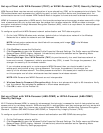
Advanced
Select to access the
Advanced Settings to configure the following options:
● Auto-Connect: Select to automatically or manually connect to a profile.
● Auto-Import this profile (for network administrators only).
● Password Protection: Select to password protect a profile.
● Mandatory Access Point: Select to associate the wireless adapter with a specific
access point.
● Start application: Specify a program to be started when a wireless connection
is made.
Back
View the prior page in the Profile Wizard.
OK
Closes the Profile Wizard and saves the profile.
Cancel
Closes the Profile Wizard and cancels any changes made.
Help?
Provides the help information for the current page.
Set up Data Encryption and Authentication
In a home wireless network, you can use a variety of simple security procedures to protect your wireless
connection. These include:
● Enable Wi-Fi Protected Access (WPA)
● Change your password
● Change the network name (SSID)
Wi-Fi Protected Access (WPA) encryption provides protection for your data on the network. WPA uses an
encryption key called a Pre-Shared Key (PSK) to encrypt data before transmission. Enter the same password in
all of the computers and access points in your home or small business network. Only devices that use the same
encryption key can access the network or decrypt the encrypted data transmitted by other computers. The
password automatically initiates the Temporal Key Integrity Protocol (TKIP) for the data encryption process.
Network Keys
WEP encryption provides two levels of security:
● 64-bit key (sometimes referred to as 40-bit)
● 128-bit key (also known as 104-bit)
For improved security, use a 128-bit key. If you use encryption, all wireless devices on your wireless network
must use the same encryption keys.
You can create the key yourself and specify the key length (64- or 128-bit) and key index (the location that a
specific key is stored). The greater the key length, the more secure the key.
Key Length: 64-bit
Pass phrase (64-bit): Enter five (5) alphanumeric characters, 0-9, a-z or A-Z.
Hex key (64-bit): Enter 10 hexadecimal characters, 0-9, A-F.
Key Length: 128-bit
Pass phrase (128-bit): Enter 13 alphanumeric characters, 0-9, a-z or A-Z.


















